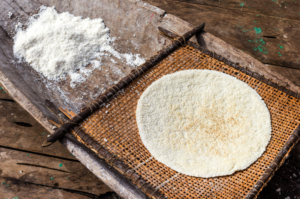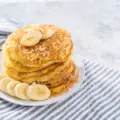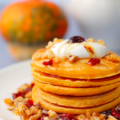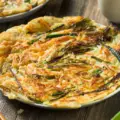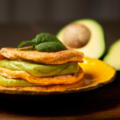Are you on a gluten-free or paleo diet and craving a fluffy and delicious pancake breakfast? Look no further! In this ultimate guide, we will show you how to make the most delectable cassava flour pancakes. Cassava flour is a grain-free and gluten-free alternative that yields a light and airy texture, making it perfect for pancakes.
If you’ve been disappointed by thin and eggy paleo pancake recipes in the past, these cassava flour pancakes will be a game-changer for you. They are fluffy, light, and incredibly satisfying. Plus, they are dairy-free and suitable for the whole family to enjoy. So, let’s dive into the world of cassava flour pancakes and discover how to make this delightful breakfast treat.
What is Cassava Flour?
Before we dive into the pancake recipe, let’s take a moment to understand what cassava flour is. Cassava flour is made from the yucca plant, a starchy root vegetable commonly found in South America and Africa. It has a fine texture and a mild flavor, making it an excellent substitute for white flour in various recipes.
One of the standout features of cassava flour is its versatility and ease of use. It can be used as a 1:1 replacement for white flour in many recipes, including pancakes. Whether you’re following a paleo diet, grain-free lifestyle, or have a nut allergy, cassava flour is a great option for creating delicious and satisfying baked goods.
The Ingredients for Perfect Cassava Flour Pancakes
To make these fluffy cassava flour pancakes, you’ll need the following ingredients:
- 1 cup cassava flour
- 1 tablespoon baking powder
- 1 tablespoon apple cider vinegar
- 1 cup coconut milk (or almond milk)
- 2 eggs
- 2 tablespoons granulated sweetener (coconut sugar, sugar-free erythritol, or regular sugar)
- 2 tablespoons melted coconut oil
- 1 teaspoon vanilla extract
Step-by-Step Instructions to Make Cassava Flour Pancakes
Now that we have all the ingredients ready, let’s walk through the step-by-step process of making these delicious cassava flour pancakes.
1. Whisk the Wet Ingredients
In a large bowl, whisk together the eggs, melted coconut oil, apple cider vinegar, and coconut milk until well combined. This mixture will serve as the base for the pancake batter.
2. Add the Dry Ingredients
Next, add the cassava flour, baking powder, granulated sweetener, and vanilla extract to the bowl with the wet ingredients. Stir everything together until a thick pancake batter forms.
It’s important not to overmix the batter, as this can make the pancakes dense. Aim for a smooth and slightly lumpy batter for the best texture.
3. Preheat the Skillet
Preheat a non-stick skillet or griddle over medium-high heat. This will ensure that the pancakes cook evenly and develop a golden-brown color.
4. Grease the Skillet
To prevent the pancakes from sticking to the skillet, lightly grease it with coconut oil or any cooking oil of your choice. This will also give the pancakes a nice crispy edge.
5. Scoop the Batter
Using a 1/4 cup measuring cup or an ice cream scoop, scoop the pancake batter onto the preheated skillet. If desired, you can spread the batter slightly with the back of a spoon to create a round pancake shape.
6. Cook the Pancakes
Cook the pancakes for about 2-3 minutes on the first side, or until bubbles start to form on the surface. This is a good indication that it’s time to flip the pancakes.
Carefully flip each pancake with a spatula and cook for an additional 1-2 minutes on the other side, or until golden brown. Repeat this process with the remaining batter.
7. Serve and Enjoy!
Once the pancakes are cooked to perfection, transfer them to a serving plate. Serve them warm with your favorite toppings, such as fresh berries, sliced bananas, syrup, or a dollop of coconut yogurt.
Now, it’s time to dig in and enjoy these fluffy and delicious cassava flour pancakes!
Tips for Perfect Cassava Pancakes
To ensure that your cassava flour pancakes turn out impeccably every time, here are some helpful tips to keep in mind:
- Measure the Cassava Flour Precisely: When measuring the cassava flour, lightly spoon it into the measuring cup and level it off with the back of a knife. Avoid packing the flour too tightly, as this can result in dense pancakes.
- Don’t Overmix the Batter: Mix the pancake batter gently until the ingredients are just combined. Overmixing can lead to tough and dense pancakes.
- Adjust the Consistency: If the batter is too thick, add a tablespoon or two of coconut milk or almond milk to thin it out. On the other hand, if the batter is too runny, add a little more cassava flour to achieve a thicker consistency.
- Cooking Temperature: Make sure to preheat the skillet or griddle over medium-high heat before adding the batter. This will help the pancakes cook evenly and develop a beautiful golden color.
- Grease the Skillet: Lightly grease the skillet with cooking oil to prevent the pancakes from sticking. This will also give the pancakes a crispy exterior.
- Flip with Care: When flipping the pancakes, use a spatula to gently lift and flip them. Be cautious not to splash hot oil or batter.
- Keep Warm: If you’re cooking multiple batches of pancakes, keep them warm by placing them on a baking sheet in a preheated oven at 200°F (93°C) while you cook the remaining batter.
FAQs
1. Can I Freeze Cassava Flour Pancakes?
Yes, you can freeze cassava flour pancakes for later use. Simply let them cool completely, then place them in a freezer-safe bag or container. They can be stored in the freezer for up to 3 months. To reheat, simply toast them in a toaster or warm them in the oven.
2. Can I Make Cassava Flour Pancakes Egg-Free?
Unfortunately, this recipe relies on eggs for the structure and texture of the pancakes. It is not recommended to make them egg-free, as the pancakes may not hold together properly.
3. Are Cassava Flour Pancakes Paleo-Friendly?
Yes, cassava flour pancakes are paleo-friendly. Cassava flour is a grain-free and paleo-approved flour substitute that can be used in various recipes.
4. Can I Substitute Coconut Milk with Almond Milk?
Yes, you can substitute coconut milk with almond milk or any other non-dairy milk of your choice. The milk acts as a liquid component in the pancake batter and helps to create a tender and fluffy texture.
